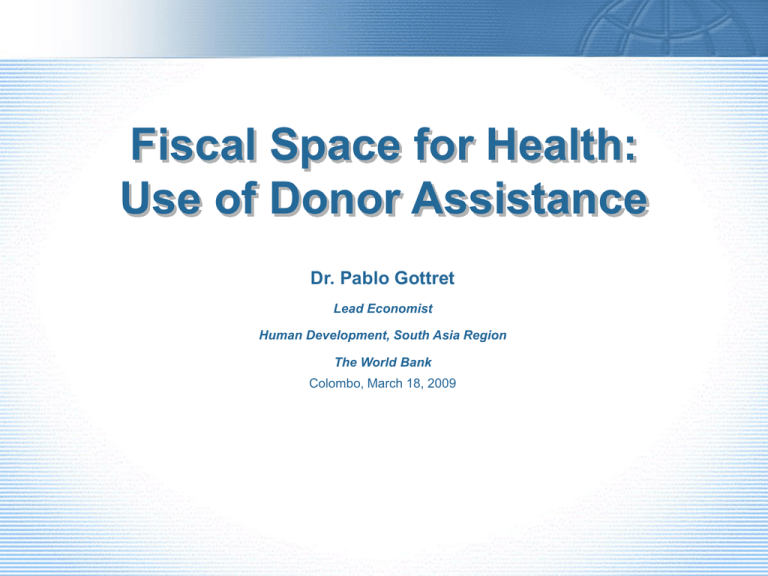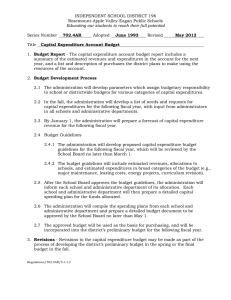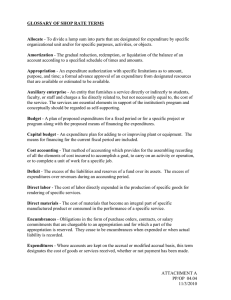Mr. Pablo Gottret
advertisement

Fiscal Space for Health: Use of Donor Assistance Dr. Pablo Gottret Lead Economist Human Development, South Asia Region The World Bank Colombo, March 18, 2009 Format • • • • What is fiscal space? Sources of fiscal space Fiscal space through donor financing Aid effectiveness – Volatility – Fungibility – Fiscal Contingencies – Fragmentation – Vertical Programming • Key messages • The Financial Crisis and Health What is Fiscal Space? • Fiscal space refers to the availability of budgetary room that allows a government to provide resources for a desired purpose without any prejudice to the sustainability of a government’s financial position. • Strong link to the notion of financial sustainability. – Financial sustainability is the capacity of governments, in future, to finance desired expenditure programs, service its debts, and ensure its solvency. – Financial returns generated by additional expenditure should cover cost of borrowing – Governments need to assess the availability of alternate source of funds to replace donor funding (grants); – Governments should be able to cover future recurrent costs, etc. Types of Questions to Pose • How are you going to finance additional expenditure? • What are the implications for expenditure in future years and can these also be financed? • Any implications for other sectors’ expenditures? If so, how will these be financed? • Is financing of today’s expenditures consistent with today’s macroeconomic policy framework (exchange rates, inflation, growth)? • Do we need to worry about how these expenditure programs, if continued, will fit into the medium-term budget and macroeconomic policy framework? • Does today’s expenditure create debt obligations that must be serviced in the future? If so, will the expenditures have an impact on the underlying growth rate? Key Expenditure Facts • Public spending accounts for less than 25% percent of total health spending in LICs, some 50% in MICs but over 60% in HICs: – • Public spending on health is some $10 per capita in LICs, over $100 in MICs, and $2000 in HICs: – • Policy-makers need to focus on improving formal risk pooling mechanisms in order to provide financial protection and protect the poor. Social health insurance accounts for some 1% of all health spending in LICs, 20% in MICs, and 30% in HICs: – • Policy-makers in LICs will be challenged to provide an essential package of basic services. Out-of-pocket payments account for 70 percent of health spending in LICs, 40 percent in MICs and 15 percent in HICs: – • Policy-makers need to focus on private spending as well as public. Policy-makers in LICs need to carefully evaluate whether they have the enabling conditions in place for SHI to succeed. While external sources on average account for only some 6 percent of total health spending in LICs, in over 20 African countries, it accounts for more than 30 percent: – Policy-makers in LICs and MICs need to keep focused on internal sources of finance, as these sources account for the bulk of their health revenues. Is there Room to Increase Public Expenditure on Health? • With share of government expenditure to GDP of 30% (about twice the current average for LIC), and health’s share at 15% of the budget (Abuja target for African countries), fiscal space is likely to be limited to around 4.5% of GDP. • Current average of public expenditure on health is about 1.35% in lowincome countries. • In an average country with GDP per capita of US$400 and population of 44 million, increasing public expenditure on health from 1.35% to (say) 5% of GDP would raise per capita health spending by less than US$15 per capita. • • There may be upper limits to increasing health spending in low-income countries without economic growth. Sources of Fiscal Space • Government budget constraint: G = Taxes + B (domestic) + ΔM + B (external) + Grants – – – – – – – • Is there potential to increase tax revenue? Can efficiency be improved? Can expenditure be reprioritized? Can borrowing be increased (domestic or external)? Is there room to print money to finance expenditure? Can you finance by receipt of grants? What is the effect of debt relief (frees up fiscal space previously used for debt service)? Must be consistent within a reasonable macroeconomic framework (e.g., taking into account impact on the exchange rate, inflation rate, etc). Fiscal Space* is Needed *Budgetary room that allows a government to provide resources for a desired purpose without any prejudice to the sustainability of its financial position Aid Expenditure Efficiency Revenue Borrow ing • Estimates of revenue effort may suggest that an additional several percent of GDP could be raised through domestic revenue measures. • Additional grants from donors are unlikely. • Spending efficiency can be improved. • Macroeconomic and debt management may suggest that new borrowing over the period should be limited. • Seignorage (govt prints money which it loans to itself) is yet another, but generally limited, mechanism for creating fiscal space. Source: World Bank, PREM:, 2007. We were asked to talk about financing public expenditure through donor funding One of the MDGs on global partnerships for development itself recognizes the need for donor assistance to attain MDGs. ODA is rising but is far short of what is needed to meet the MDGs. Moreover, ODA is largely irrelevant for a large number of countries in the region Financing Public Expenditure via Donor Funding 80 % of net ODA 70 60 50 40 30 20 10 0 1980 1990 Debt Forgiveness Grants 2000 Technical Cooperation Administrative Costs Program and Project Aid Emergency and Food Aid Much of the increase in aid is not directed towards financing the incremental costs of attaining the MDGs. Growth in Bilateral Donor Assistance for Health Aid Effectiveness Aid has diminishing returns. There are limits to country ‘absorptive capacity’. Aid is fungible overall (can offset budget contributions) and among sectors. Aid achieves better results in good policy environments. Aid requires ownership by countries (e.g., donor imposed conditionalities or preferences rarely work). Aid is related to increased investments and growth. Aid has high transaction costs for countries. Aid makes governments accountable to donors as opposed to their citizens. Aid in the form of grants instead of loans may reduce domestic resource mobilization efforts. Financing Public Expenditure via Donor Funding Trend in HIV/AIDS Financing Relative to Total DAH 2000-2005 Percent 100 80 60 40 20 0 16 84 2000 15 85 2002 Health 32 68 2004 43 57 2005 HIV/AIDS Financing Large part of the increase is going to vertical programs. Source: OECD DAC Some Key Problems mentioned about donor aid • Volatility: Making it difficult to finance recurrent expenditures • Fungibility: Government expenditures decline as donor funding increases and therefore there is no real additional financing for health • Distortions generated by donor funding, specially through the financing of vertical programs • Sustainability: Donor funding must be replaced at some reasonable point in time for domestic financing. This domestic financing must fit appropriately within the domestic macroeconomic framework Donors are not a really big player in health financing in most counties External Resources for Health, Average 2000-2006 India Sri Lanka Maldives Pakistan Afghanistan Bangladesh Nepal Bhutan 0 10 20 Percent of Total Health Expenditure Source: World Health Organization 30 Households (OOP) finance a large proportion of health expenditures Categories of Health Expenditure, Average 2000-2006 Afghanistan Bangladesh Bhutan India Maldives Nepal Pakistan Sri Lanka 0 20 40 60 80 Percent of Total Health Expenditure Government Out-of-pocket Private (w/o out-of-pocket) Source: World Health Organization 100 Donors seem to play an increasing role as a %of GE, but some of the funding may be off budget External Resources for Health, Average 2004-2006 Maldives Sri Lanka India Pakistan Bangladesh Bhutan Nepal Afghanistan 0 20 40 Percent of Government Health Expenditure Source: World Health Organization 60 Volatility is still an issue 50 External Resources for Health, 1995 - 2006 30 40 Bhutan 20 Nepal 10 Bangladesh 0 Afghanistan 1995 Source: World Health Organization 2000 Year 2005 No excessive donor concentration on disease specific funding Official Development Assistance for Health (ODAH) by Category Average 2004-2006 Afghanistan Bangladesh Bhutan India Maldives Nepal Pakistan Sri Lanka 0 20 40 60 80 100 Percent of Total ODAH Health Systems/Pop RH Source: OECD DAC Disease Specific No excessive donor concentration on disease specific funding Official Development Assistance for Health (as % of Government Health Expenditure) Average 2004-2006 Afghanistan Bangladesh Bhutan India Maldives Nepal Pakistan Sri Lanka 0 50 100 Health Systems/Pop RH Source: OECD DAC 150 200 Disease Specific Fungibility of Aid Some evidence that aid is fungible: e.g., increasing aid for health may imply that the government reduces expenditure on health and spends it on something else. Some estimates show that only 3.6% of total aid is used to finance health expenditure, even though health’s proportion in total aid tends to be around 17%. Others have argued that it is important to distinguish between aid that is in the budget versus aid that is off-budget. Is Aid Fungible? Some empirical evidence that aid is fungible, but there is high variance across countries and across sectors. How bad is the current crisis Growth is expected to decline significantly across developed and developing countries in 2009 • Growth in emerging and developing countries will fall from 6.25% in 2008 to 3.25% in 2009 (World Bank, 2009) • GDP expected to decline by 4-6% in the euro area in 2009 (World Bank, 2009) • The US and Europe have been the hit first, with US GDP falling by 3.8% (annualized) in the fourth quarter of 2008 (World Bank, 2009) • Many currencies have experienced large devaluations How does the current crisis compare with previous ones East Asian Crisis (1997-1998), Argentinian Crisis (2001), Russian Crisis (1997-1998), Peruvian Crisis (1988-92), Mexican Crises (1980s and 1990s) • • Previous Crisis – Originated in developing countries – Many countries had large fiscal & external deficits – A large part of the effort to resume growth was to increase exports to developed countries. Current Crisis – Originated in developed countries – Many countries with better fiscal positions also likely to face a crisis. – The importance of FDI has increased – Large number of poor countries, especially in Africa are Aid dependent for financing government expenditure in general and health in particular. – Remittances constitute an important source of foreign exchange and direct support to household in many developing countries From Crisis to Health Status Economic •Unemployment •Foreign aid/FDI •Tax Revenue •Demand for exports Household Income Government Resources Demand for health services Capacity of other actors (NGOs, private sector) Supply of health Services / Quality Access to quality health care Health Status Potential consequences of the crisis • Women and Children are the worst affected. Nutrition outcomes and IMR increase are decline at slower rates. The impact of outcomes tends to be more severe in the poorest quintiles of the population. • • • Previous crises in Asia and LAC show the negative impact that crises can have on health and nutrition outcomes - may have been the result of sharp reductions of utilization of essential health services. Devaluation increases the price of drugs in local currency and impacts access by the population, specially the poor. Faced with reduced income, households may increase demand for publically financed (and in many countries provided) health services. However: – Total public expenditures in social sectors in many crises countries (those facing high external and internal imbalances) tend to be pro-cyclical. – Government Health Expenditures (GHE) per capita in real terms declined in all countries reviewed immediately after a crisis. This decline occurred even as many countries protected GHE as a proportion of total government expenditures – Capture of government services by the non-poor was known to have increased during crises in some cases Good and not so good efforts by governments in past crisis – Not so good • Protecting expenditures for the whole sector as a proportion of Government Expenditures. • Targeting budgetary commitments which may be quite different from actual government expenditures in health. • Protecting expenditures without evaluating whether the expenditures were pro-poor to start with. – Good practices • Supporting the financing of the initiation or expansion of a sustainable safety net that tied essential health services to identified financing on a per capita basis with an appropriate system of monitoring and evaluation THUS…. • Fundamental objective of public policy in health during a crisis must be to maintain/improve access to essential services by the population, especially the poor and vulnerable – • From this perspective, protecting government health expenditures is not an objective in itself, but maintaining/improving access to essential services is Key Messages • • • • Domestic financing – Low levels of public spending on health in many countries – Large OOP with the corresponding implications regarding the absence of financial protection from catastrophic spending – Increasing expenditures in the short-term must take into consideration Fiscal Space constraints Donor funding for health is increasing rapidly but is largely concentrated in SSA. – Donor funding is not as relevant as a percentage of Total Health Expenditures in the SA Region – However, Donor Funding is still important for the financing of certain government programs Challenges of current donor assistance for health in the region – Insufficient resources – Volatility – Fungibility The financial crisis – Will impact the ability of governments to increase and even sustain current levels of domestic expenditures in health – Government must aim ensuring access to essential services specially for the poor and vulnerable with particular attention to mothers and children that are the hardest hit during crisis. THANK YOU

